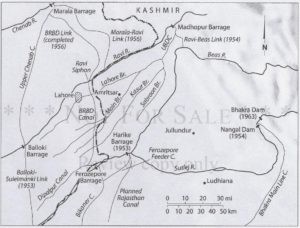Book: David Haines (2017). Indus Divided: India, Pakistan and the Indus Basin Dispute. Penguin, Publishers
As the twenty-first century deepens, water is only going to get more important. Growth, pollution, climate change, these are all now intertwined in such complicated ways that water — its availability, its reliability, its price, its conservation, its distribution within a stratified society, and how it travels from point A to point B, not to mention point Z, — is increasingly at the forefront of political decision-making and political tussles everywhere. The dispute over sharing of water from Indus River Basin between two neighboring nations namely India and Pakistan needs to be viewed in this and other contexts like both nations primarily being agrarian economies, both overburdened with ever-increasing water demands for development, and both sharing common river basin, the Indus, which in the case of Pakistan is the only river basin available to it. What makes the matter further hopeless for that nation is the fact that Pakistan ranks very high among the nations depending on water from outside their territory. Looking through the prism of past it is no surprise that in spite of Indus Water Treaty 1962 (henceforth IWT), the water-disputes between two co-riparian, instead of ceasing, actually escalated within a decade of signing the Treaty, pointing to a systemic intrinsic ill-flawed approach to resolution. The fundamental flaw in IWT is that it offers no scientific mechanism/rationale of ‘sharing’ water from the six rivers of Indus river basin, rather is solely based on the ‘division of rivers’ on a whimsically hypothetical invisible illusion in the minds of those authoring IWT – three rivers to each nation.
Bifurcation of British India into India and Pakistan, not only divided lands but also divided water (structures) in such a tragic way that water-heads (sources of water) fell to India and their elaborate networks went to Pakistan, making ‘water’ a casus belli between the two countries (figure 1). It is corroborated by Pakistan’s failed efforts to take control of Kashmir immediately after independence in 1948 and subsequently in 1965 by directly wedging a war on Kashmir front.
Numerous texts available on IWT, till date, broadly fall in two categories – first, the lengthy process of negotiations (1950-1962) and second the legacy of treaty and its success despite 4 wars between two nuclear-powered neighbors [Incidentally, the most important factor involving the success of IWT has never been put on record – IWT has largely been successful as India didn’t utilize its share of water – 3.6 Million Acre Feet (MAF) – for irrigation and electricity, well within the norms laid down in the IWT, from the three rivers allocated to Pakistan]. Nevertheless it is not the issue in question here. Haines consciously appears avoided taking any of these two routes and chose to adopt a fresh independent approach by creating a geographical and historical mosaic and elaborates post-colonial concepts of sovereignty and territoriality as well as rights over water between two countries which eventually led to fructification of IWT.

Figure-1: Partition of 1947 and aftermath on water(Source: Prof. David Gilmartin (2015))
Haines proposes that upper and lower riparian positions have shaped and defined the ‘sovereignty’ inter-twined with water rights, in both Pakistan and India. Further the colonial rationale that water is a primary resource for ‘national development’ and hence needs to be controlled also suited to both the nations. The claims and counter-claims of different states within both these nations further complicated the negotiations over sharing of Indus water went at snail’s pace. Haines has successfully covered such multi-layered and multi-dimensional complications in a simplified reader-friendly manner.
Two chapters on Kashmir and Punjab, and their borderlands, are crisp and analytical to demonstrate how the edifices of sovereignty and territoriality were defied and figured throughout the course of Indus waters dispute. Exploring the ‘water’ and ‘Kashmir’ dispute, Haines argued that the nuances of territory are completely undermined and subverted in Kashmir. Pakistan’s claims over Kashmir are made on strong cultural and religious grounds as well as on the basis of hydro-geography giving a convolute logic – “right to water conferred a right to control territory.” While discussing Punjab Haines raises the issue of ‘fixed and stable territory’ challenged by the ever-changing river-courses, thereby modifying inter-relationship among river flow, border spaces and territoriality. Furthermore, local players – influential farmer lobby (read Zamindari) and politicians – thwarted any effort to impose territoriality from the above, demonstrating deep fault-lines regarding ‘territory’ and ‘sovereignty’ within the nation-building.
The last two chapters exclusively cover the extra-ordinarily lengthy process of negotiations between two nations on sharing of water from Indus River. Haines draws two significant inferences, from the content and direction of the formal negotiations. First, internal politics over water within both the nations (internalization of water politics) emerged as a major bottleneck in resolving the issue on technical criteria and secondly and finally the political dimension completely overshadowed everything to reach a political agreement. Need not to say that the then prevailing cold-war politics also played a critical role in culmination of treaty, in the backdrop of Pakistan aligned with USA-led forces and India chose to be non-aligned. The heavily Pakistan-tilted final IWT is a testimony of various factors influencing the outcome.
The first five chapters have furnished a very detailed interesting analysis and conceptual narrative to keep reader glued to the book but somehow the last two chapters slacken on this account. Too much has been written and read on the issue of negotiation-process of IWT may be a plausible explanation. Nevertheless, this shortcoming does not come in the way of overall treatment given to the subject and the book is a treat for those involved with the issue of water in South Asia.
Author – Arun K Singh

Recent Comments